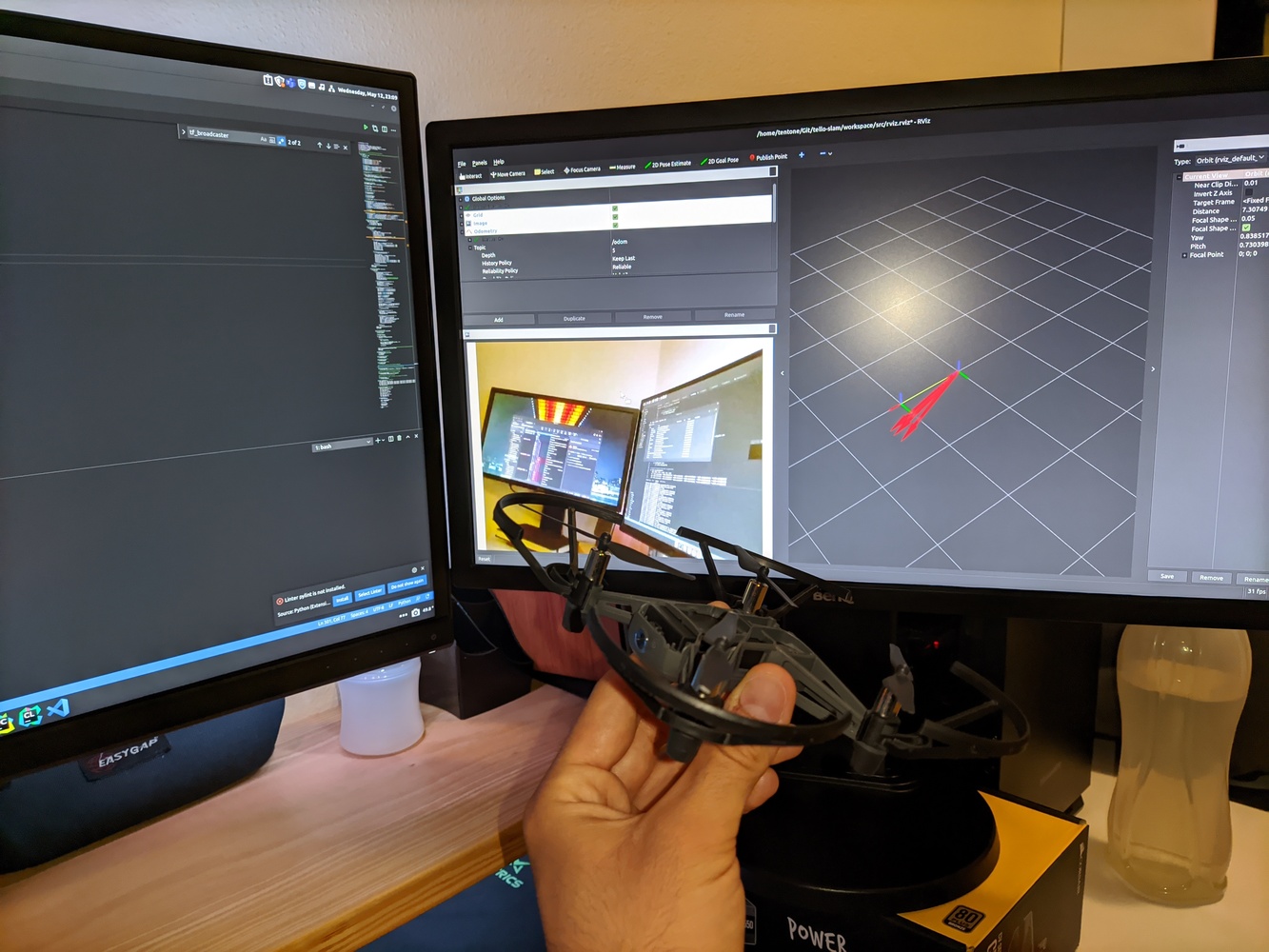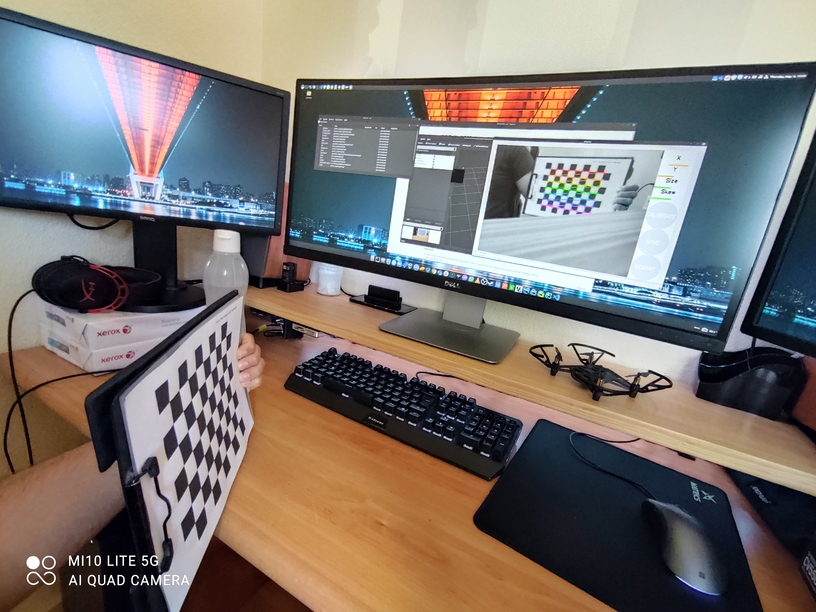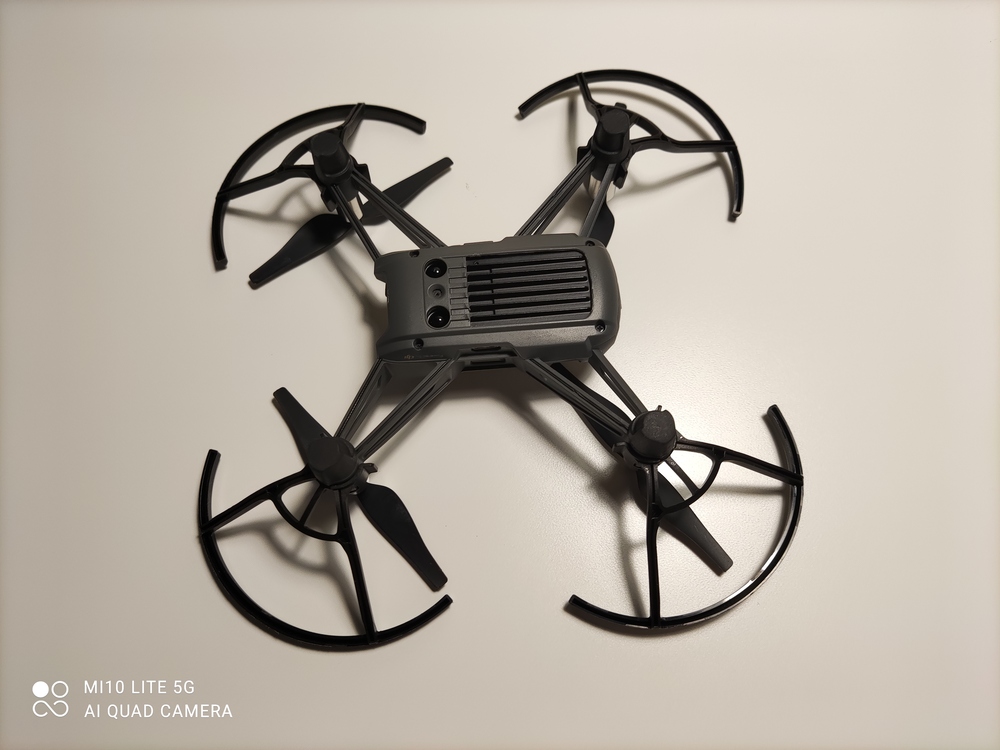No version for distro humble. Known supported distros are highlighted in the buttons above.
No version for distro jazzy. Known supported distros are highlighted in the buttons above.
No version for distro kilted. Known supported distros are highlighted in the buttons above.
No version for distro rolling. Known supported distros are highlighted in the buttons above.

|
tello-ros2 repositorydrone slam ros2 dji-tello ros-foxy dji-tello-edu orbslam2 tello tello_control tello_msg |
|
|
Repository Summary
| Description | ROS2 node for DJI Tello and Visual SLAM for mapping of indoor environments. |
| Checkout URI | https://github.com/tentone/tello-ros2.git |
| VCS Type | git |
| VCS Version | main |
| Last Updated | 2023-01-09 |
| Dev Status | UNMAINTAINED |
| CI status | No Continuous Integration |
| Released | UNRELEASED |
| Tags | drone slam ros2 dji-tello ros-foxy dji-tello-edu |
| Contributing |
Help Wanted (0)
Good First Issues (0) Pull Requests to Review (0) |
Packages
| Name | Version |
|---|---|
| orbslam2 | 0.0.1 |
| tello | 0.0.1 |
| tello_control | 0.0.1 |
| tello_msg | 0.0.1 |
README
DJI Tello ROS2
- DJI Tello driver for ROS 2 based on DJITelloPy that uses the official SDK for the drone.
- Can be used to control multiple drones both using the swarm functionality (only for Tello EDU) or using multiple WLAN with regular Tello drones.
- This project was developed as a way of learning ROS 2 and evaluate the viability of moving other in progress projects from ROS 1 to ROS 2.
- Ii is recommended to update the Tello firmware to the latest version available
- Project workspace is divided into sub-workspaces that contain different logic.
-
tellopackage is the main package, includes access to the drone information, camera image and control. -
tello_msgpackage defines custom messages to access specific Tello data.- Defines the
TelloStatus,TelloIDandTelloWifiConfigmessages
- Defines the
-
tello_controlpackage is a sample control package that displays the drone image and provides keyboard control.- T used for takeoff, L to land the drone, F to flip forward, E for emergency stop, WASD and arrows to control the drone movement.
-


- Bellow is the list of topics published and consumed by the
tellopackage - The list of published topics alongside their description and frequency. These topics are only published when some node subscribed to them, otherwise they are not processed.
| Topic | Type | Description | Frequency |
|---|---|---|---|
| /image_raw | sensor_msgs/Image | Image of the Tello camera | 30hz |
| /camera_info | sensor_msgs/CameraInfo | Camera information (size, calibration, etc) | 2hz |
| /status | tello_msg/TelloStatus | Status of the drone (wifi strength, batery, temperature, etc) | 2hz |
| /id | tello_msg/TelloID | Identification of the drone w/ serial number and firmware | 2hz |
| /imu | sensor_msgs/Imu | Imu data capture from the drone | 10hz |
| /battery | sensor_msgs/BatteryState | Battery status | 2hz |
| /temperature | sensor_msgs/Temperature | Temperature of the drone | 2hz |
| /odom | nav_msgs/Odometry | Odometry (only orientation and speed) | 10hz |
| /tf | geometry_msgs/TransformStamped | Transform from base to drone tf, prefer a external publisher. | 10hz |
- The list of topics subscribed by the node, these topics can be renamed in the launch file.
| Topic | Type | Description |
|---|---|---|
| \emergency | std_msgs/Empty | When received the drone instantly shuts its motors off (even when flying), used for safety purposes |
| \takeoff | std_msgs/Empty | Drone takeoff message, make sure that the drone has space to takeoff safely before usage. |
| \land | std_msgs/Empty | Land the drone. |
| \control | geometry_msgs/Twist | Control the drone analogically. Linear values should range from -100 to 100, speed can be set in x, y, z for movement in 3D space. Angular rotation is performed in the z coordinate. Coordinates are relative to the drone position (x always relative to the direction of the drone) |
| \flip | std_msgs/String | Do a flip with the drone in a direction specified. Possible directions can be “r” for right, “l” for left, “f” for forward or “b” for backward. |
| \wifi_config | tello_msg/TelloWifiConfig | Configure the wifi credential that should be used by the drone. The drone will be restarted after the credentials are changed. |
- The list of parameters used to configure the node. These should be defined on a launch file.
| Name | Type | Description | Default |
|---|---|---|---|
| connect_timeout | float | Time (seconds) until the node is killed if connection to the drone is not available. | 10.0 |
| tello_ip | string | IP of the tello drone. When using multiple drones multiple nodes with different IP can be launched. | ‘192.168.10.1’ |
| tf_base | string | Base tf to be used when publishing data | ‘map’ |
| tf_drone | string | Name of the drone tf to use when publishing data | ‘drone’ |
| tf_pub | boolean | If true a static TF from tf_base to tf_drone is published | False |
| camera_info_file | string | Path to a YAML camera calibration file (obtained with the calibration tool) | ’’ |
Camera Calibration
- To allow the drone to be used for 3D vision tasks, as for example monocular SLAM the camera should be first calibrated.
- A sample calibration file is provided with parameters captures from the drone used for testing but it is recommended to perform individual calibrations for each drone used.
- Calibration can be achieved using the camera_calibration package. Calibration pattern can be generated using the calib.io pattern generator tool.
ros2 run camera_calibration cameracalibrator --size 7x9 --square 0.16 image:=/image_raw camera:=/camera_info
- Take as many frame as possible and measure your check board grid size to ensure good accuracy in the process. When the process ends a
calibrationdata.tar.gzwill be created in the/tmppath.

Launch File
- Launch files in ROS2 are now defined using python code. To launch the main node of the project add the following code to your
launch.pyfile.
Node(
package='tello',
executable='tello',
namespace='/',
name='tello',
parameters=[
{'tello_ip': '192.168.10.1'}
],
remappings=[
('/image_raw', 'camera')
],
respawn=True
)
Overheating Problems
- The motor drivers in the DJI Tello overheat after a while when the drone is not flying. To cool down the drivers i have removed the plastic section on top of the heat spreader (as seen in the picture).
- If you are comfortable with leaving the PCB exposed removing the plastic cover should result in even better thermals.
- If possible place the drone on top of an old computer fan or use a laptop cooler to prevent the drone from shutting down due to overheating.

Install
- To install the driver download the code from git, install dependencies using the
script/install.shscript. - After all dependencies are installed build the code and and install using
colconas usual or use thescript/build.shandscript/run.shto test the code.
Visual SLAM
- The drone is equipped with a IMU and a camera that can be used for visual SLAM in order to obtain the location of the drone and a map of the environment.
- ORB SLAM 2 is a monocular visual based algorithm for SLAM that can be easily integrated with the Tello drone using this package.
- The wrapper provided alongside with this repository is based on the alsora/ros2-ORB-SLAM2 project using the alsora/ORB_SLAM2 modified version of ORB Slam that does not depend on pangolin.
- To run the monocular SLAM node after installing all dependencies and building the package run.
ros2 run ros2_orbslam mono <VOCABULARY FILE> <CONFIG_FILE>
- The vocabulary file can be obtained from the ORB_SLAM2 repository (
ORB_SLAM2/Vocabulary/ORBvoc.txt). - Sample configuration files can be found inside the package at
orbslam2/src/monocular/config.yamlfor monocular SLAM.
Setup ROS 2 Foxy
- Run the install script to setup the ROS 2 (Foxy Fitzroy) environment.
- Check the ROS2 Tutorials page to learn how to setup workspace and create packages.
Workspace
- To install dependencies of the packages available in a workspace directory
srcrunrosdep install -i --from-path src --rosdistro foxy -y -
To build workspace you can use the command
colcon build, some useful arguments forcolcon build:-
--packages-up-tobuilds the package you want, plus all its dependencies, but not the whole workspace (saves time) -
--symlink-installsaves you from having to rebuild every time you tweak python scripts -
--event-handlers console_direct+shows console output while building (can otherwise be found in thelogdirectory)
-
Packages
- To create a new ROS2 package (C++ or Python) for development move to the
srcpackage and run
# CPP Package
ros2 pkg create --build-type ament_cmake --node-name <node_name> <package_name>
# Python Package
ros2 pkg create --build-type ament_python --node-name <node_name> <package_name>
Tools
-
rqt_topicUsed to monitor topics and their values in a list -
rqt_graphDraw the graph of connection between the currently active nodes and explore communication between them -
rvizVisualize topics in 3D space.
Bags
- Bags can be used to record data from topics that can be later replayed for off-line testing. Bags can be manipulated using the
ros2 bagcommand. To
# Record a bag containing data from some topics into a file
ros2 bag record -o <bag_file_name> /turtle1/cmd_vel /turtle1/pose ...
# Check the content of a bag run the command
ros2 bag info <bag_file_name>
# Replay the content of some topics recorded into a bag file
ros2 bag play <bag_file_name>
- To play ROS 1 bags in ROS 2 you will need to first install ROS 1, and the ROS bag adapter plugin. The the bags can be run using the command.
ros2 bag play -s rosbag_v2 <path_to_bagfile>
Camera calibration
- Calibration files provided were obtained using our test drone.
- To get your own calibration file use the ROS camera calibration tool
Ubuntu Based Linux Distros
- When installing on ubuntu based distros it might be required to change the distro codename so that the
lsb_release -cscommand returns the correct ubuntu base distribution. - To change the output of the
lsb_releasecommand edit the/etc/os-releasefile. For ubuntu 20.04 the codename should befocal. - Edit the file to contain the value
UBUNTU_CODENAME=focal.
Windows Subsystem for Linux (WSL)
- Install WSL2 from the windows store or using the commands bellow, install Ubuntu 20.04 as the SO over the WSL overlay.
# Install WSL 2
Enable-WindowsOptionalFeature -Online -FeatureName Microsoft-Windows-Subsystem-Linux
# Enable WSL 2
dism.exe /online /enable-feature /featurename:VirtualMachinePlatform /all /norestart
# Check WSL version
wsl.exe --set-default-version 2
wsl -l -v
- Install a VcXsrv Windows X Server to be used as a X11 display server required to run GUI applications.
- “Native opengl” unchecked
- “Disable access control” checked
- Create a shortcut for VcXSrv with the following parameters
"C:\Program Files\VcXsrv\vcxsrv.exe" :0 -ac -terminate -lesspointer -multiwindow -clipboard -wgl -dpi auto
- To enable the access to the installed server add the display address to the
.bashrcfile
export DISPLAY="`grep nameserver /etc/resolv.conf | sed 's/nameserver //'`:0"
export LIBGL_ALWAYS_INDIRECT=0
- If you are using Visual Studio Code as and IDE you can configure for remote WSL development, allowing to debug code and interact with the WSL terminal.
-
If you require CUDA acceleration you can also install NVidia CUDA drivers for WSL2
- If you get
Clock skew detected. Your build may be incomplete.while compiling the code run the following commands or install the wsl-clock tool to automatically fix the clock drift problems.
sudo apt install ntpdate
sudo ntpdate time.windows.com
CONTRIBUTING
No CONTRIBUTING.md found.
No version for distro noetic. Known supported distros are highlighted in the buttons above.
No version for distro galactic. Known supported distros are highlighted in the buttons above.
No version for distro iron. Known supported distros are highlighted in the buttons above.
No version for distro melodic. Known supported distros are highlighted in the buttons above.